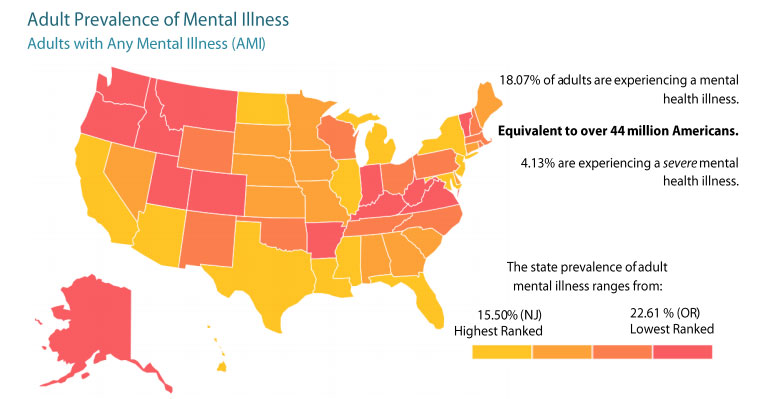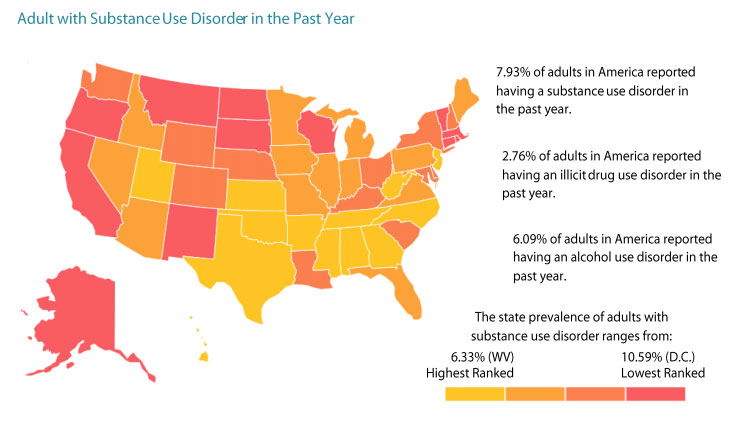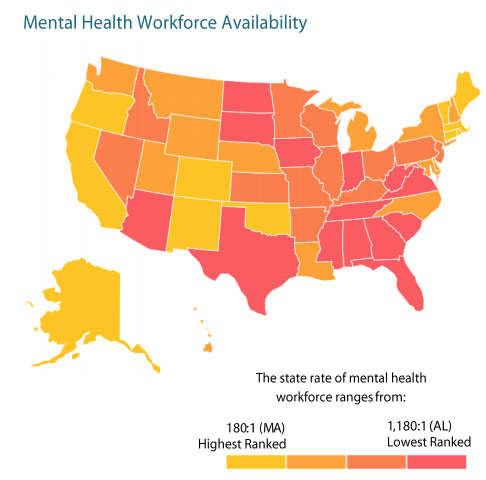Mental health care availability and access vary tremendously depending on where you live in the United States. In Massachusetts, for example, there is one mental health care provider for every 180 residents. That ratio is far different in Texas and Alabama, however, where there are more than 1,000 residents for every one provider.
Mental Health America (MHA) recently released its annual report of mental health indicators across the U.S. For the ratios above, MHA included counselors, psychiatrists, psychologists, licensed clinical social workers, marriage and family therapists, and nurses specializing in mental health care in its categorization of “mental health provider.”
MHA ranked Massachusetts as the best state for mental health care availability, followed by the District of Columbia, Maine, Oregon, Vermont, Oklahoma, New Mexico, Rhode Island, Alaska and Connecticut. All of these states and the District of Columbia have fewer than 300 residents per mental health care provider.
On the other end of the spectrum, Alabama (with 1,180 residents for every one provider) and Texas (1,010:1) were the lowest-ranked states, along with West Virginia (890:1), Georgia (830:1), Arizona (820:1), Mississippi and Iowa (760:1), Tennessee (740:1), and Florida and Indiana (700:1).
Although Oregon was near the top of MHA’s list for mental health care availability, it also ranked highest for prevalence of mental illness among adults. Nationwide, 18.07 percent of adults – or more than 44 million people – have a mental illness, defined as “a diagnosable mental, behavioral or emotional disorder, other than a developmental or substance use disorder.”

In Oregon, that prevalence was 22.61 percent, followed by Utah (22.27 percent), Kentucky (22.08 percent), Idaho (21.62 percent) and Arkansas (21.02 percent). West Virginia, Vermont, Washington, Montana, Colorado and Alaska followed with rates that were between 20 and 21 percent.
States with the lowest prevalence of adult mental illness included New Jersey (15.5 percent), Hawaii (15.55 percent), Illinois (15.73 percent), Texas (16.04 percent) and Maryland (16.59 percent). North Dakota, California, Florida, Louisiana, Michigan, Mississippi, Arizona, New York, Maine, Delaware, Iowa, Georgia and South Dakota all had rates between 17 and 18 percent.
MHA, a Virginia-based nonprofit advocacy organization, compiles a report titled The State of Mental Health in America each year from nationwide survey data, including information from the Substance Abuse and Mental Health Services Administration and the Centers for Disease Control and Prevention. Released this fall, MHA’s current report includes statistics on access to mental health care, uninsured citizens, rates of substance abuse, suicide indicators, youth depression and other factors.

****
Mental Health America’s The State of Mental Health in America 2019
When it comes to mental health, how does your state stack up?
View the full report and state rankings at mentalhealthamerica.net

****
Follow Counseling Today on Twitter @ACA_CTonline and on Facebook at facebook.com/CounselingToday.
****
Opinions expressed and statements made in articles appearing on CT Online should not be assumed to represent the opinions of the editors or policies of the American Counseling Association.

Comments are closed.